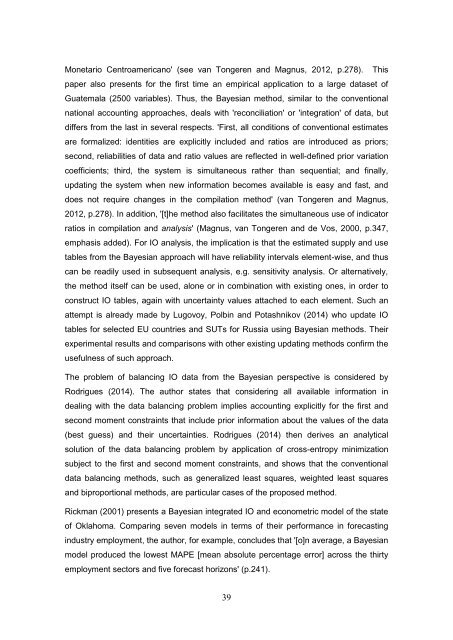Uncertainty treatment in input-output analysis
ifDakU
ifDakU
You also want an ePaper? Increase the reach of your titles
YUMPU automatically turns print PDFs into web optimized ePapers that Google loves.
Monetario Centroamericano' (see van Tongeren and Magnus, 2012, p.278). This<br />
paper also presents for the first time an empirical application to a large dataset of<br />
Guatemala (2500 variables). Thus, the Bayesian method, similar to the conventional<br />
national account<strong>in</strong>g approaches, deals with 'reconciliation' or '<strong>in</strong>tegration' of data, but<br />
differs from the last <strong>in</strong> several respects. 'First, all conditions of conventional estimates<br />
are formalized: identities are explicitly <strong>in</strong>cluded and ratios are <strong>in</strong>troduced as priors;<br />
second, reliabilities of data and ratio values are reflected <strong>in</strong> well-def<strong>in</strong>ed prior variation<br />
coefficients; third, the system is simultaneous rather than sequential; and f<strong>in</strong>ally,<br />
updat<strong>in</strong>g the system when new <strong>in</strong>formation becomes available is easy and fast, and<br />
does not require changes <strong>in</strong> the compilation method' (van Tongeren and Magnus,<br />
2012, p.278). In addition, '[t]he method also facilitates the simultaneous use of <strong>in</strong>dicator<br />
ratios <strong>in</strong> compilation and <strong>analysis</strong>' (Magnus, van Tongeren and de Vos, 2000, p.347,<br />
emphasis added). For IO <strong>analysis</strong>, the implication is that the estimated supply and use<br />
tables from the Bayesian approach will have reliability <strong>in</strong>tervals element-wise, and thus<br />
can be readily used <strong>in</strong> subsequent <strong>analysis</strong>, e.g. sensitivity <strong>analysis</strong>. Or alternatively,<br />
the method itself can be used, alone or <strong>in</strong> comb<strong>in</strong>ation with exist<strong>in</strong>g ones, <strong>in</strong> order to<br />
construct IO tables, aga<strong>in</strong> with uncerta<strong>in</strong>ty values attached to each element. Such an<br />
attempt is already made by Lugovoy, Polb<strong>in</strong> and Potashnikov (2014) who update IO<br />
tables for selected EU countries and SUTs for Russia us<strong>in</strong>g Bayesian methods. Their<br />
experimental results and comparisons with other exist<strong>in</strong>g updat<strong>in</strong>g methods confirm the<br />
usefulness of such approach.<br />
The problem of balanc<strong>in</strong>g IO data from the Bayesian perspective is considered by<br />
Rodrigues (2014). The author states that consider<strong>in</strong>g all available <strong>in</strong>formation <strong>in</strong><br />
deal<strong>in</strong>g with the data balanc<strong>in</strong>g problem implies account<strong>in</strong>g explicitly for the first and<br />
second moment constra<strong>in</strong>ts that <strong>in</strong>clude prior <strong>in</strong>formation about the values of the data<br />
(best guess) and their uncerta<strong>in</strong>ties. Rodrigues (2014) then derives an analytical<br />
solution of the data balanc<strong>in</strong>g problem by application of cross-entropy m<strong>in</strong>imization<br />
subject to the first and second moment constra<strong>in</strong>ts, and shows that the conventional<br />
data balanc<strong>in</strong>g methods, such as generalized least squares, weighted least squares<br />
and biproportional methods, are particular cases of the proposed method.<br />
Rickman (2001) presents a Bayesian <strong>in</strong>tegrated IO and econometric model of the state<br />
of Oklahoma. Compar<strong>in</strong>g seven models <strong>in</strong> terms of their performance <strong>in</strong> forecast<strong>in</strong>g<br />
<strong>in</strong>dustry employment, the author, for example, concludes that '[o]n average, a Bayesian<br />
model produced the lowest MAPE [mean absolute percentage error] across the thirty<br />
employment sectors and five forecast horizons' (p.241).<br />
39


